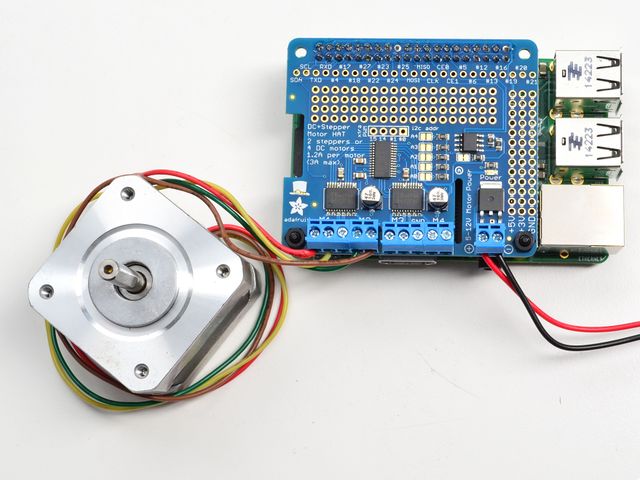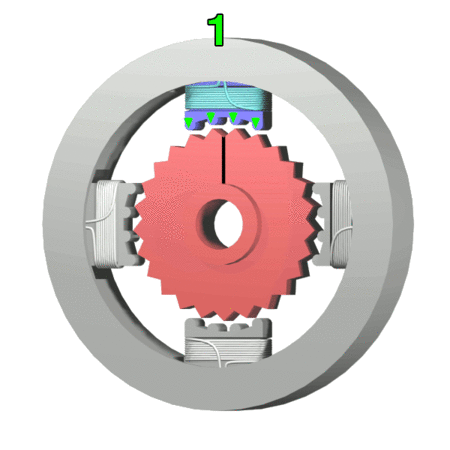Rasp-Hat-Moteur-Moteurs-pas-a-pas
|
|
En cours de traduction/élaboration. |
Utiliser des moteurs pas-à-pas
Stepper motors are great for (semi-)precise control, perfect for many robot and CNC projects. This HAT supports up to 2 stepper motors. The python library works identically for bi-polar and uni-polar motors
Running a stepper is a little more intricate than running a DC motor but its still very easy

Crédit: AdaFruit Industries www.adafruit.com
Connecter des moteurs pas-à-pas
Pour cette démonstration, utilisé M1 et M2 pour connecter le moteur.
Après avoir raccordé le moteur (voir ci-dessous), rendez vous dans le répertoire Adafruit-Motor-HAT-Python/examples et exécutez la commande sudo python StepperTest.py pour voir le moteur pas-à-pas tourner dans un sens puis l'autre.
Pour les moteurs unipolaires
to connect up the stepper, first figure out which pins connected to which coil, and which pins are the center taps. If its a 5-wire motor then there will be 1 that is the center tap for both coils. Theres plenty of tutorials online on how to reverse engineer the coils pinout. The center taps should both be connected together to the GND terminal on the Motor HAT output block. then coil 1 should connect to one motor port (say M1 or M3) and coil 2 should connect to the other motor port (M2 or M4).
Pour les moteurs bipolaires
its just like unipolar motors except theres no 5th wire to connect to ground. The code is exactly the same.
Contrôler un moteur pas-à-pas
Here's a walkthru of the code which shows you everything the MotorHAT library can do and how to do it.
Start with importing at least these libraries:
#!/usr/bin/python
from Adafruit_MotorHAT import Adafruit_MotorHAT, Adafruit_DCMotor, Adafruit_StepperMotor
import time
import atexit
The MotorHAT library contains a few different classes, one is the MotorHAT class itself which is the main PWM controller. You'll always need to create an object, and set the address. By default the address is 0x60 (see the stacking HAT page on why you may want to change the address)
# create a default object, no changes to I2C address or frequency
mh = Adafruit_MotorHAT(addr = 0x60)
Even though this example code does not use DC motors, it's still important to note that the PWM driver is 'free running' - that means that even if the python code or Pi linux kernel crashes, the PWM driver will still continue to work. This is good because it lets the Pi focus on linuxy things while the PWM driver does its PWMy things.
Stepper motors will not continue to move when the Python script quits, but it's still strongly recommend that you keep this 'at exit' code, it will do its best to shut down all the motors:
# recommended for auto-disabling motors on shutdown!
def turnOffMotors():
mh.getMotor(1).run(Adafruit_MotorHAT.RELEASE)
mh.getMotor(2).run(Adafruit_MotorHAT.RELEASE)
mh.getMotor(3).run(Adafruit_MotorHAT.RELEASE)
mh.getMotor(4).run(Adafruit_MotorHAT.RELEASE)
atexit.register(turnOffMotors)
Créer un objet moteur pas-à-pas
OK now that you have the motor HAT object, note that each HAT can control up to 2 steppers. And you can have multiple HATs!
To create the actual Stepper motor object, you can request it from the MotorHAT object you created above with getStepper(steps, portnum) where steps is how many steps per rotation for the stepper motor (usually some number between 35 - 200) ith a value between 1 and 2. Port #1 is M1 and M2, port #2 is M3 and M4
myStepper = mh.getStepper(200, 1) # 200 steps/rev, motor port #1
Next, if you are planning to use the 'blocking' step() function to take multiple steps at once you can set the speed in RPM. If you end up using oneStep() then this step isn't necessary. Also, the speed is approximate as the Raspberry Pi can't do precision delays the way an Arduino would. Anyways, we wanted to keep the Arduino and Pi versions of this library similar so we kept setSpeed() in:
myStepper.setSpeed(30) # 30 RPM
Les pas
Stepper motors differ from DC motors in that the controller (in this case, Raspberry Pi) must tick each of the 4 coils in order to make the motor move. Each two 'ticks' is a step. By alternating the coils, the stepper motor will spin all the way around. If the coils are fired in the opposite order, it will spin the other way around.
If the python code or Pi crashes or stops responding, the motor will no longer move. Compare this to a DC motor which has a constant voltage across a single coil for movement.

"StepperMotor" par Wapcaplet; Teravolt.
There are four essential types of steps you can use with your Motor HAT. All four kinds will work with any unipolar or bipolar stepper motor
- Single Steps - this is the simplest type of stepping, and uses the least power. It uses a single coil to 'hold' the motor in place, as seen in the animated GIF above
- Double Steps - this is also fairly simple, except instead of a single coil, it has two coils on at once. For example, instead of just coil #1 on, you would have coil #1 and #2 on at once. This uses more power (approx 2x) but is stronger than single stepping (by maybe 25%)
- Interleaved Steps - this is a mix of Single and Double stepping, where we use single steps interleaved with double. It has a little more strength than single stepping, and about 50% more power. What's nice about this style is that it makes your motor appear to have 2x as many steps, for a smoother transition between steps
- Microstepping - this is where we use a mix of single stepping with PWM to slowly transition between steps. It's slower than single stepping but has much higher precision. We recommend 8 microstepping which multiplies the # of steps your stepper motor has by 8.
while (True):
print("Single coil steps")
myStepper.step(100, Adafruit_MotorHAT.FORWARD, Adafruit_MotorHAT.SINGLE)
myStepper.step(100, Adafruit_MotorHAT.BACKWARD, Adafruit_MotorHAT.SINGLE)
print("Double coil steps")
myStepper.step(100, Adafruit_MotorHAT.FORWARD, Adafruit_MotorHAT.DOUBLE)
myStepper.step(100, Adafruit_MotorHAT.BACKWARD, Adafruit_MotorHAT.DOUBLE)
print("Interleaved coil steps")
myStepper.step(100, Adafruit_MotorHAT.FORWARD, Adafruit_MotorHAT.INTERLEAVE)
myStepper.step(100, Adafruit_MotorHAT.BACKWARD, Adafruit_MotorHAT.INTERLEAVE)
print("Microsteps")
myStepper.step(100, Adafruit_MotorHAT.FORWARD, Adafruit_MotorHAT.MICROSTEP)
myStepper.step(100, Adafruit_MotorHAT.BACKWARD, Adafruit_MotorHAT.MICROSTEP)
step() - fonction bloquante
As you can see above, you can step mulitple steps at a time with step()
step(number_de_pas, direction, type)
Where nombre_de_pas is the number of steps to take, direction is either FORWARD or BACKWARD and type is SINGLE, DOUBLE, INTERLEAVE or MICROSTEP
| Note that INTERLEAVE will move half the distance of SINGLE or DOUBLE because there are twice as many steps. And MICROSTEP will move 1/8 the distance because each microstep counts as a step! |
This is the easiest way to move your stepper but is blocking - that means that the Python program is completely busy moving the motor. If you have two motors and you call these two procedures in a row:
stepper1.step(100, Adafruit_MotorHAT.FORWARD, Adafruit_MotorHAT.SINGLE)
stepper2.step(100, Adafruit_MotorHAT.BACKWARD, Adafruit_MotorHAT.SINGLE)
Then the first stepper will move 100 steps, stop, and then the second stepper will start moving.
Chances are you'd like to have your motors moving at once!
For that, you'll need to take advantage of Python's ability to multitask with threads which you can see in DualStepperTest.py
The key part of the DualStepperTest example code is that we define a function that will act as a 'wrapper' for the step() procedure:
def stepper_worker(stepper, numsteps, direction, style):
#print("Steppin!")
stepper.step(numsteps, direction, style)
#print("Done")
We have some commented-out print statements in case you want to do some debugging.
Then, whenever you want to make the first stepper move, you can call:
st1 = threading.Thread(target=stepper_worker, args=(myStepper1, numsteps, direction, stepping_style))
st1.start()
Which will spin up a background thread to move Stepper1 and will return immediately. You can then do the same with the second stepper:
st2 = threading.Thread(target=stepper_worker, args=(myStepper2, numsteps, direction, stepping_style))
st2.start()
You can tell when the stepper is done moving because the stepper thread you created will 'die' - test it with st2.isAlive() or st2.isAlive() - if you get True that means the stepper is still moving.
oneStep() - fonction non bloquante
Source: Adafruit DC and Stepper Motor HAT for Raspberry Pi
Créé par LadyAda pour AdaFruit Industries.
Traduction réalisée par Meurisse D pour MCHobby.be.
Toute référence, mention ou extrait de cette traduction doit être explicitement accompagné du texte suivant : « Traduction par MCHobby (www.MCHobby.be) - Vente de kit et composants » avec un lien vers la source (donc cette page) et ce quelque soit le média utilisé.
L'utilisation commercial de la traduction (texte) et/ou réalisation, même partielle, pourrait être soumis à redevance. Dans tous les cas de figures, vous devez également obtenir l'accord du(des) détenteur initial des droits. Celui de MC Hobby s'arrêtant au travail de traduction proprement dit.
Traduit avec l'autorisation d'AdaFruit Industries - Translated with the permission from Adafruit Industries - www.adafruit.com